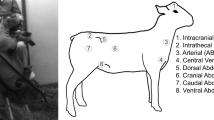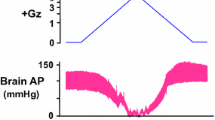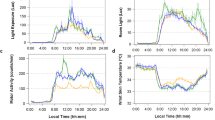Summary
Six anesthetized female rhesus monkeys were studied to determine the effect of head-down tilt on renal function. Head-down tilt is believed to simulate zero gravity. Some animals were tilted from 0° to −5° or −10° and others from +10° to −10°. None of these maneuvers consistently altered renal function. These results are in accord with those reported in early literature for the human but contrary to more recent reports. The interpretation of the latter are seriously hampered by experimental design. If indeed zero gravity translocates blood to the thorax with a resultant diuresis and natriuresis, headdown tilt is not an appropriate model for weightlessness.
Similar content being viewed by others
References
Cathcart ES, Williams ITD (1955) The effect of the head-down position on the excretion of certain urinary constituents. Clin Sci 14:121–124
Gilmore JP, Zucker IH (1978) Contribution of vagal pathways to the renal responses to head-out immersion in the nonhuman primate. Circ Res 42 (2):263–267
Hargens AR, Tipton CM, Gollnick PD, Mubarak SJ, Tucker BJ, Akeson WH (1983) Fluid shifts and muscle function in humans during acute simulated weightlessness. J Appl Physiol: Respirat Environ Exercise Physiol 54(4):1003–1009
Nixon JV, Murray RG, Bryant C, Johnson RL Jr, Mitchell JH, Holland OB, Gomez-Sanchez C, Vergne-Marini P, Blomqvist CG (1979) Early cardiovascular adaptation to simulated zero gravity. J Appl Physiol: Respirat Environ Exercise Physiol 46(3):541–548
Viar WN, Oliver BB, Eisenberg S, Lombardo TA, Willis K, Harrison TR (1951) The effect of posture and of compression of the neck on excretion of electrolytes and glomerular filtration: further studies. Circulation 3:105–115
Volicer L, Jean-Charles R, Chobanian AV (1976) Effects of head-down tilt on fluid and electrolyte balance. Aviat Space Environ Med 47(10):1065–1068
Wilkins RW, Bradley SE, Friedland CK (1950) The acute circulatory effects of the head-down position (negative G) in normal man, with a note on some measures designed to relieve cranial congestion in this position. J Clin Invest 29:940–949
Zucker IH, Gilmore JP (1978) Contribution of peripheral pooling to the renal response to immersion in the dog. J Appl Physiol: Respirat Environ Exercise Physiol 45(5):786–790
Zucker IH, Gilmore JP (1975) Responsiveness of type B atrial receptors in the monkey. Brain Res 95:159–165
Author information
Authors and Affiliations
Additional information
This work was supported by National Institutes of Health Grant No. 13427
Rights and permissions
About this article
Cite this article
Gilmore, J.P., Nemeh, M.N. Does head-down tilt simulate zero gravity?. Basic Res Cardiol 79, 262–267 (1984). https://doi.org/10.1007/BF01908025
Received:
Issue Date:
DOI: https://doi.org/10.1007/BF01908025




